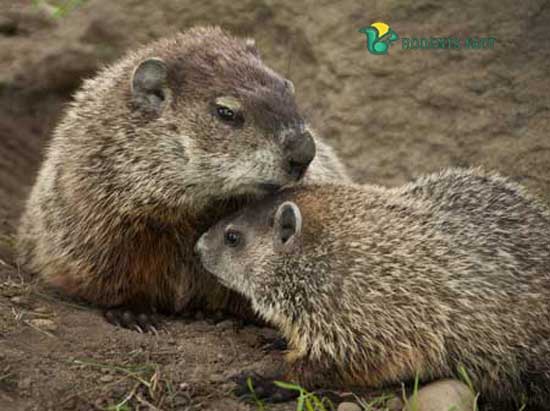Differentiating Male vs. Female Groundhogs: A Quick Guide
From building burrows that are 20 feet long to swim and climb trees for safeguarding- there are tons of new data about groundhogs every day. But if you think the male and female groundhogs behave the same-you are probably wrong!
There are behavioral and habitual differences, we bet! Check out the list of differences of male vs. female groundhogs-which one is in your garden?

Female vs Male Groundhog: A Comparison Table
| Male groundhog | Female groundhog | |
|---|---|---|
| Size | Slightly larger than females | Smaller than males |
| Weight | Heavier than females | Weigh slightly less |
| Hibernation | Come out of hibernation much earlier | Tend to hibernate for longer periods of time |
| Aggression | Males are territorial and use scent glands to mark their territories. | Have smaller territories and are more defensive than attackers |
| Social behavior | Live a solitary life, except when mating | They’re more social and stay in family groups |
You can easily tell between a male and female groundhog by looking at its size. The males are slightly larger than the females in terms of length. They’re also heavier than females.
The males also usually emerge from hibernation 1-3 weeks earlier than the females.
Males have been observed to eat up to 700 lbs of food before going into a deep sleep while females tend to keep the same amount of food in their tunnels before they enter hibernation.
In terms of behavior temperament, males tend to be more aggressive while females are more defensive than attackers. Other than this, they seem to portray pretty much the same behavior.

It’s also worth noting that both males and females create the same type of burrow systems. But during late spring or early summer, females tend to expand their territories.
Males are more territorial and tend to defend their territories against invasion by other males. This is unlike in females where their ranges tend to overlap up to 10% more or less.
You can also tell the difference between the animals by checking around their genital areas. Male groundhogs have a scrotum and penis while females feature an easily visible vulva.
Male Groundhogs vs. Female Groundhogs
A groundhog is a look-alike of squirrels and is from a rodent family. But keep in mind that groundhogs are larger than squirrels. These usually have heavy-set low-slung bodies. However, when it comes to the tail, they fall short. Yes, they have short tails.
But don’t forget that the tail is bushy. On the other hand, the legs are short too. But unless you have seen a groundhog doing their job, you won’t know how strong their legs are! While only a few mammals hibernate, they get into hibernation in the winter.
Male and Female Groundhog Names
Well, we all know groundhogs and woodchucks are different names of the same mammal. Both male and female ones look similar. But there are old terms that you can use for calling the different genders. So, what is a female groundhog called?
These are usually called she-chucks. And so, can you guess what is a male groundhog called? You guessed it right- he-chucks! Kid groundhogs are called cubs or kits mostly.
Weight of Male and Female Groundhogs
If you check any average groundhog, you will see that they weigh more or less 5 pounds to 10 pounds. And the amazing fact is they are male groundhogs and the female ones look almost similar. But there are differences in terms of weight.
Among the groundhogs, you can find some lighter woodchucks too. So, are lighter groundhogs male or female? Well, male woodchucks tend to weigh more than female groundhogs.
Size of Male and Female Groundhogs
From their head to tail everything is covered with fur. The average size of the woodchucks you see in your yard is usually 16 inches to 20 inches long.
As we have discusses before, male groundhogs and female groundhogs look identical. But in terms of the length of a woodchuck, males are usually a little longer than the female. Also, they both live underneath the ground.
Then why are they called woodchucks? Do they chuck wood? Learn about how much wood could a woodchuck chuck?
Male and Female Groundhogs Hibernation
Yes, this is their mating season. In short, they search for female burrows. It’s easy for them because of their eyesight! Check more about it in- do groundhogs have good eyesight!
If the male one gets a female burrow, he gets into it. According to beliefs, it is mostly known that male groundhogs are the ones that come forward to introduce themselves to the female groundhogs when it comes to the breeding season.
Male and Female Groundhog Territories
Female groundhogs and male groundhogs create the same type of burrows. But when it is late spring, the female groundhogs might try to expand their territories. This might happen in early summer too. The ranges of female groundhogs might overlap more or less 10%.
On the contrary, if you talk about the male groundhogs, they have non-overlapping territories. Their territories overlap within one to three female territories (mature female territories.)
Communication between Groundhogs
As we all know, groundhogs live alone. They do not live in groups. And this is for their safety. Right after the hibernation period ends, the male groundhog gets out in search of a female burrow. In this case, they usually have no communication before.
And even after the mating season, they do not stay in contact. So, do male and female groundhogs live together in the same burrow or hole? No, they don’t. They just meet for the breeding season and the male groundhogs leave afterward.
So, you can tell that daddy groundhogs don’t stay in the same burrow with the mother groundhog. But can they forget their females? No, right! This is why they keep visiting the female groups! This happens throughout the first month after the breeding season.
Though the male one doesn’t stay home, it comes to meet the female groups at least once a day till the infant reaches its first month.
This is a story about the communication between female and male groundhogs. But what about the same gender! Well, female group interactions when it comes to these cuties are rare.
At times, they are shared by the same male adult. But even then, their communication is rare. Also, you can say that the interaction between the female groundhog groups is usually aggressive.
Raising Newborns
After a newborn groundhog comes out, it stays with the motor woodchuck for about 3 months at best and then, it leaves the mother burrow to build a new burrow. Once the mating season is done, the baby groundhog is the responsibility of the female woodchuck.
She takes care of the baby and nurses the kid. From feeding to helping the kid developing his skills, the mother is the one that teaches him everything. She gets out of the burrow, arranged the baby’s food, and nurses her.
Till the kids reach 2-3 weeks, they are not allowed to go out. However, the father’s groundhog doesn’t forget the infant so fast! This is why he visits the female groups once a day. It goes on till the infant reaches one month.
You can learn more interesting facts about groundhogs like this here, take a look! Well, after that, the baby groundhog becomes a responsibility of his mother. She doesn’t have to take care of him for long. Right when the kid reaches 3 months, he gets out to create his burrow leaving the mother’s nest!
Wrap Up
So, no matter how similar the male and female groundhogs are, there are basic differences in their habits and behaviors. From their care for the children to the way they build their territory, the dissimilarities are visible. However, if you look from the above, you will only see their cute face. That’s enough at times, isn’t it?





